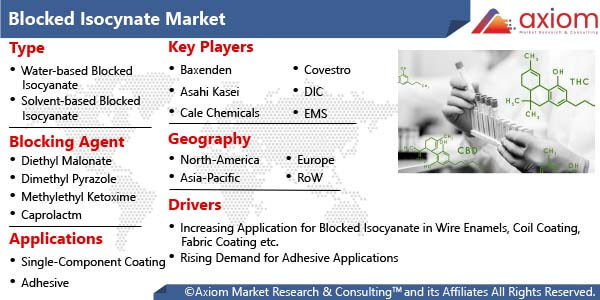Blocked isocyanates are reaction products of isocyanates, which at higher temperature dissociate to reform the original isocyanate group. Blocked isocyanates are typically manufactured from hydrogen-containing compounds such as phenol, ethyl acetoacetate and ?-caprolactam. Typical unblock temperatures are 90-200 °C, depending on the isocyanate structure and the blocking agent. The aromatic isocyanates are typically unblocked at lower temperatures than those required to unblock aliphatic isocyanates. The dissociation temperature decreases according to the order of blocking agents such as, alcohols, lactams, phenols, oximes, and pyrazoles. Products such as methylethylcetoxime, diethyl malonate, and 3,5-dimethylpyrazole are typical blocking agents.
Blocked Isocyanate Market Outlook
The global blocked isocyanate market is witnessing significant growth owing to high demand from current & emerging applications, demand from emerging economies, and advancement in technology. Isocyanates are extensively being used in paints & varnishes, flooring materials and decorations in housing industry. Additionally, increasing demand from furniture industry as carpet cushion and mattress padding is anticipated to exponentially boost isocyanate market over the forecast period. However, the market is hampered by high raw material cost and huge investments required in R&D and technology.
Blocked Isocyanate Market Segmental Overview
The report analyses the global blocked isocyanate market based on type, blocking agent, application and geography.
Blocked Isocyanate Market by Type
Based on type, the market is categorized into water-based blocked isocyanate and solvent-based blocked isocyanate. Water-based blocked isocyanates do not react until they are exposed to their deblocking temperature at which point they are deblocked. Once deblocked, blocked isocyanates react like traditional isocyanates. Bayhydur water-dispersible aliphatic hydrophilically modified polyisocyanate crosslinkers from Covestro are widely used for the formulation of water-based polyurethanes for adhesives, automotive coatings, can and coil coatings, construction/flooring coatings, glass coatings, industrial coatings etc.
Blocked Isocyanate Market by Blocking Agents
Various blocking agents of this market are segmented into Diethyl malonate (DEM), Dimethyl pyrazole (DMP), Methylethyl ketoxime (MEKO) and ?-Caprolactam (?-CAP). Commonly used isocyanate blocking agents include phenol, nonyl phenol, methylethylketoxime (MEKO), alcohols, ?-caprolactam, amides, imidazoles, and pyrazoles. The chemical structure of the blocking group has a major impact on the deblocking temperature and cure rate of the coating or adhesive, and impact volatile content and final properties. Phenols and nonyl phenols have been employed as isocyanate capping agents for many years, but recent health concerns over toxicity of these molecules motivated consumers to look for safer and affordable alternatives.
Blocked Isocyanate Market by Application
Based on application, the blocked isocyanate market is categorized into adhesives & sealants, automotive coatings, coil coating, electrostatic coatings, white goods and other. Coating applications such as electro-deposition, electro-static spraying, powder coating, insulating wire coating, and coil coatings have extensively explored as they provide a solution to minimize health concerns from free isocyanate exposure while allowing coatings to cure by heat.
Blocked Isocyanate Market by Geography
By geography, the global blocked isocyanate market is studied across the countries of key regions such as, North America, Europe, Asia Pacific and rest of the world regions which includes Latin America, and Middle East & Africa. Asia Pacific accounted for the largest market share in 2018, primarily driven by increasing manufacturing output coupled with supportive government regulations in countries such as China, India, and Japan. Consumer markets, including equipment and electronics, automotive and construction, in the emerging economies will present enormous opportunities for manufacturers and suppliers in the future especially the ones involved in coating applications. Developed regions such as North America and Europe are also expected to show substantial demand for blocked isocyanate due to the increasing regulatory intervention from agencies such as EPA regarding environmental and health effects.
Blocked Isocyanate Market Key Players
The leading blocked isocyanate market players are BAXENDEN, Asahi KASEI, Cale Chem, Covestro, DIC, EMS, Evonik AG, Jiang Xing Industry, Leeson Polyurethanes, Meisei Chem, Mitsui Chemicals, Rudolf, Shiquanxing, Tosoh and Vencorex. Covestro supplies blocked isocyanates and prepolymers for coatings under the trade names Desmodur BL, Desmocap and Sumidur BL. The Desmodur product line includes aromatic and aliphatic (light-stable) diisocyanates, polyisocyanates and prepolymers for the formulation of one- (1K) and two-component (2K) polyurethane systems. Whereas, the Desmocap branched aromatic ether/urethane resins from Covestro are effective flexibilizers for epoxy coatings and sealants.











